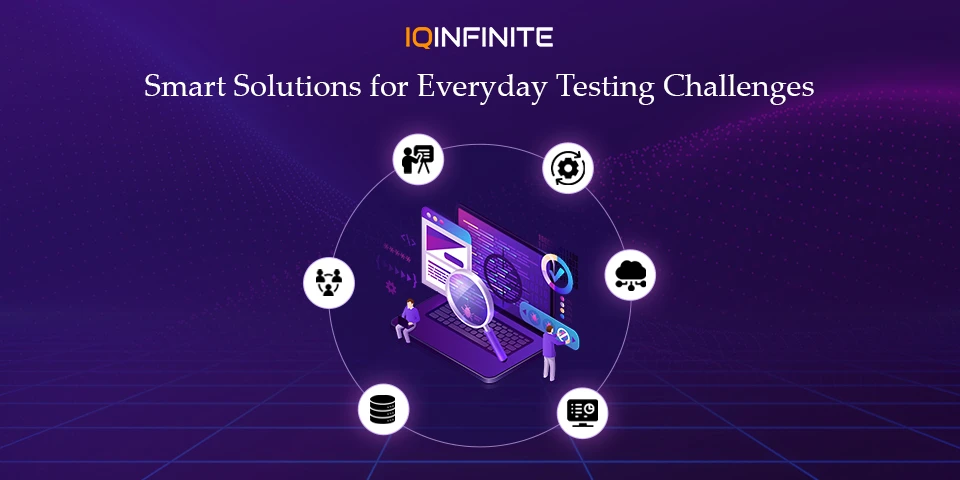Testing Challenges and Their Solutions

In today’s digital-first world, delivering reliable and high-performing software is no longer optional it’s a necessity. Software testing plays a vital role in ensuring quality but testers often face numerous challenges that can slow down releases, increase costs or compromise user satisfaction.
The good news? Every challenge has a solution. Let’s explore some of the most common testing challenges and practical ways to overcome them.
1. Incomplete or Changing Requirements
The Challenge:
Unclear or constantly changing requirements make it difficult to design accurate test cases. This often leads to gaps in coverage and unexpected defects.
The Solution:
• Collaborate closely with stakeholders for clarity.
• Embrace Agile methodologies that accommodate evolving requirements.
• Maintain a single source of truth (e.g., Jira, Confluence) to track and manage requirement updates.
Unclear or constantly changing requirements make it difficult to design accurate test cases. This often leads to gaps in coverage and unexpected defects.
The Solution:
• Collaborate closely with stakeholders for clarity.
• Embrace Agile methodologies that accommodate evolving requirements.
• Maintain a single source of truth (e.g., Jira, Confluence) to track and manage requirement updates.
2. Tight Deadlines and Limited Time
The Challenge:
Testing is usually left until the end of the development cycle, leaving minimal time for thorough validation.
The Solution:
• Adopt a shift-left approach by starting to test earlier.
• Focus on risk-based testing to cover high-impact areas first.
• Automate repetitive tasks, freeing testers for critical exploratory work.
Testing is usually left until the end of the development cycle, leaving minimal time for thorough validation.
The Solution:
• Adopt a shift-left approach by starting to test earlier.
• Focus on risk-based testing to cover high-impact areas first.
• Automate repetitive tasks, freeing testers for critical exploratory work.
3. Shortage of Skilled Resources
The Challenge:
Finding professionals with expertise in automation, performance and security testing is difficult.
The Solution:
• Invest in continuous learning and training programs.
• Build cross-functional teams were knowledge flows between developers and testers.
• Use low-code/no-code automation tools to reduce skill dependency.
Finding professionals with expertise in automation, performance and security testing is difficult.
The Solution:
• Invest in continuous learning and training programs.
• Build cross-functional teams were knowledge flows between developers and testers.
• Use low-code/no-code automation tools to reduce skill dependency.
4. Test Environment Constraints
The Challenge:
Unstable or misconfigured test environments cause delays and unreliable results.
The Solution:
• Adopt cloud-based environments for better scalability and availability.
• Automate setup and deployment with CI/CD, Docker or Kubernetes.
• Regularly monitor and refresh environments to avoid bottlenecks.
Unstable or misconfigured test environments cause delays and unreliable results.
The Solution:
• Adopt cloud-based environments for better scalability and availability.
• Automate setup and deployment with CI/CD, Docker or Kubernetes.
• Regularly monitor and refresh environments to avoid bottlenecks.
5. Managing Test Data
The Challenge:
Inconsistent or insufficient test data can lead to poor coverage and missed defects.
The Solution:
• Generate synthetic test data when real data is unavailable.
• Apply data masking to protect sensitive information.
• Refresh test data regularly to simulate production-like conditions.
Inconsistent or insufficient test data can lead to poor coverage and missed defects.
The Solution:
• Generate synthetic test data when real data is unavailable.
• Apply data masking to protect sensitive information.
• Refresh test data regularly to simulate production-like conditions.
6. High Maintenance of Automation Scripts
The Challenge:
Frequent application changes often break automation scripts, making maintenance time-consuming.
The Solution:
• Build modular, reusable test scripts to minimize rework.
• Leverage tools with AI-powered self-healing capabilities.
• Continuously review and optimize the automation suite.
Frequent application changes often break automation scripts, making maintenance time-consuming.
The Solution:
• Build modular, reusable test scripts to minimize rework.
• Leverage tools with AI-powered self-healing capabilities.
• Continuously review and optimize the automation suite.
7. Striking the Right Balance Between Manual and Automation Testing
The Challenge:
Too much reliance on manual testing slows down delivery, while over-automation without strategy wastes resources.
The Solution:
• Automate repetitive, stable and regression test cases.
• Reserve manual testing for exploratory, usability and edge scenarios.
• Continuously evaluate the ROI of automation efforts.
Too much reliance on manual testing slows down delivery, while over-automation without strategy wastes resources.
The Solution:
• Automate repetitive, stable and regression test cases.
• Reserve manual testing for exploratory, usability and edge scenarios.
• Continuously evaluate the ROI of automation efforts.
Conclusion
Testing may come with its fair share of challenges, but with the right practices, tools and mindset, these obstacles can be transformed into opportunities for better quality and efficiency.
By clarifying requirements, investing in skilled teams, modernizing environments and striking the right balance between manual and automated testing, organizations can not only deliver defect-free software but also build a culture of quality.
By clarifying requirements, investing in skilled teams, modernizing environments and striking the right balance between manual and automated testing, organizations can not only deliver defect-free software but also build a culture of quality.
